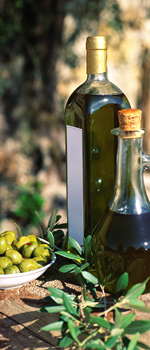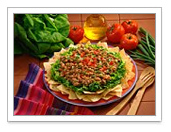
|
Follow Me On: |
 |
Brent Prockish Brent Prockish Team at Total Lending Concepts Phone: 913-444-9194 License: 229476 Brent@TLCLender.com www.BrentProckish.com |
 | ||
| ||||
April 2011

|
Olive Oil The Culinary World's Most Important Commodity By Kirk Leins
Given its many uses, olive oil may well be the most essential food item found in any kitchen. Not only is it a wonderful medium in which to cook, it's also a critical ingredient for many dishes, as well as a complementary, yet understated condiment. Follow me on a gastronomic journey, complete with tips for tasting olive oil, not to mention a few delectable recipes that aptly feature this wonderful product. Olive oil can be a complicated subject. Like wine, it is produced in many different countries, each lending their own indigenous characteristics to the oil. Also like wine, many olive oils are intended for specific uses, even specific foods. That being said, my plan is to proceed logically and judiciously. Instead of looking at the subject as a whole, I'll focus on the olive oils from a country that produces some of the world's finest: Italy. Tasting To begin an olive oil tasting, Chandler suggests pouring a small amount into a wine glass. Examine the color; it can range from a golden yellow to a bright green. It is not uncommon to find sediment within the oil as many of the artisan varieties are left unfiltered. Don't let this scare you. It's actually a very good sign. Allow the olive oil to slightly warm by holding your hand on the bottom of the glass as opposed to the stem. Cover the top of your glass with your other hand and give it a swirl. Lift your hand from the top, put your nose into the glass, and smell it, really smell it. Chandler says that if the oil smells rancid, it has gone bad and there's no need to taste. He says the aroma should be closer to that of vegetables, herbs, or even grass. Now it's time to give it a taste. When it comes to flavor, olive oil runs the gamut. Instead of looking at this as an overwhelming obstacle, use it to your advantage. Write down what you taste for future reference. Chandler says, "One oil may taste like almonds, while another may invoke the flavor of fresh herbs." An example he gives of a regional taste characteristic is the oil from Tuscany and its tendency to be peppery. One last thing to examine when tasting olive oil is its viscosity, or thickness, which can be light, medium, or heavy. The point is that once you've determined each of the individual characteristics, you can better pair the oil with food. Types In the past, oil was extracted from the olives by putting them through a press. Nowadays, the task is mostly accomplished via centrifuge. With either method, no heat is applied to the olives during extraction. This first pressing or centrifuging of the olives is what produces the oil known as extra virgin. Virgin olive oil is also a by-product of the aforementioned process, but refers to any oil that is above the 1% acidity level. There's also lower grade oil known as pomace. Produced by applying heat to the olive paste left behind from the first pressing, the paste is pressed again for a second yielding of oil. Chandler says because of the lower price, many restaurants use this type of oil in their cooking. However, he urges home cooks to stay away from it because of the marked inferiority in taste. Now it's time to cook with a few different olive oils: one to drizzle as a condiment, one to use as an ingredient in vinaigrette, and one to cook with. Recipe #1 The oil I recommend with this recipe is Gianfranco Becchina Olio Verde. From Sicily, this oil is a wonderful balance of grassy, fruity, and peppery. Authentic Italian Bruschetta
Preheat your oven's broiler. Place slices of bread onto a baking sheet, and broil in the oven until a light golden brown (approximately 2 minutes on one side and 1 minute on the other). Remove from broiler. Generously rub the top of each slice with the cut side of the garlic. Lightly brush each slice with olive oil and sprinkle with salt. Arrange the bread on a platter and serve alongside the diced tomatoes, basil, and the bottle of olive oil you've chosen to use. Grab a slice, spoon on a few tomatoes, top with basil (that you've torn by hand), drizzle with a touch more olive oil...and enjoy. Recipe #2 For this recipe, I used Vittorio Cassini olive oil. Produced in Liguria, Chandler describes this intensely yellow oil as having a lighter fragrance and body. He describes the taste as delicate with almond overtones. While Vittorio Cassini oil meshes well with more pungent ingredients, it also lends its own uniqueness to recipes such as vinaigrette. Carrot-Sherry Vinaigrette
In a bowl, whisk together mustard, carrot juice, and vinegar. While continuing to whisk, slowly drizzle in the olive oil. Once the vinaigrette has emulsified, season to taste with salt and pepper. In Burgundy, a classic service for this vinaigrette would be in a salad comprised of baby arugula, sliced radish, and raw beets sliced paper-thin. Feel free, however, to utilize it in any type of salad, or even as a condiment for steamed or roasted asparagus. No matter how you use it, I would suggest a garnish of sliced almonds that have been lightly toasted as a way to mimic the almond nuances in the oil. Recipe #3 Unlike the previous offerings, this recipe will use the olive oil as a vehicle for cooking the dish. I used Frantoio Franci Toscano IGP. IGP is a European Union designation that covers the entire region of Tuscany and refers to oil that has been produced from start to finish within Tuscany. This includes everything – from the olive growing through the bottling. Frantoio Franci Toscano has an acidity level of .6% and every bottle is numbered, providing enough information to research its production. Chandler describes the oil's fragrance as having medium intensity with a clear scent of olives, artichokes, and ripe fruit. He says it is an outstanding all-purpose olive oil. Chicken with 40 Cloves
Preheat oven to 350 degrees. Rub chicken with a touch of olive oil, and season generously with salt and pepper. On your stovetop, heat 2 tablespoons of olive oil in a large oven-safe skillet. Brown the chicken pieces on both sides. Remove the skillet from heat. Add garlic cloves, fresh thyme, and the half-cup of oil. Cover and bake for 1 hour or until breasts reach an interior temperature of 160 degrees and thighs reach 175 degrees. Remove the chicken pieces to a platter and allow them to rest for 5 minutes. Meanwhile, use a slotted spoon to remove the garlic cloves from the skillet and transfer them to a small serving bowl. Serve the chicken and garlic alongside a green salad and crusty bread. Use the cooked garlic cloves as a smear for the bread. Our journey is now complete! I hope you enjoyed it, while also learning a little something about olive oil. Before I say goodbye, I'd like to urge you to visit www.olio2go.com. Whether you purchase Chandler's olive oils for your own kitchen, or as a gift for someone else, you can't go wrong. The worst-case scenario is that you'll get hooked on this important and delicious ingredient.
| ||||||||||||||||||||||||||||||||
Total Lending Concepts NMLS #1043976 (Corporate) #2348348 (KS Branch) 6900 College Blvd., Suite 800, Overland Park, KS, 66211 (KS Office) 219 E Broadway, Columbia, MO. 65203 (MO Office) You are receiving a complimentary subscription to YOU Magazine as a result of your ongoing business relationship with Brent Prockish. While beneficial to a wide audience, this information is also commercial in nature and it may contain advertising materials. INVITE A FRIEND to receive YOU Magazine. Please feel free to invite your friends and colleagues to subscribe. SUBSCRIBE to YOU Magazine. If you received this message from a friend, you can subscribe online. UNSUBSCRIBE: If you would like to stop receiving emails from Brent Prockish, you can easily unsubscribe. Brent Prockish Team at Total Lending Concepts |
6900 College Blvd., Suite 800 Overland Park, KS 66211 Powered by Platinum Marketing © Copyright 2024. Vantage Production, LLC. | |||||||||



